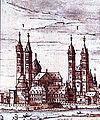Bishop's Palace Speyer
Coordinates: 49 ° 19 ′ 3.3 " N , 8 ° 26 ′ 35.7" E

The Bischofspfalz zu Speyer is an expired bishop's residence next to the Speyer Cathedral .
The location of the first bishop's seat is not certain, nor is that of the Vorsalischen cathedral, but it seems obvious to look for it on the top of the river terrace near today's cathedral.
The bishop's palace was first mentioned in a document in 1270, but it is very likely that it existed a long time before. At the time of the first mention, it was located on the north side of the cathedral, similar to, for example, the Worms Bishop's Palace (the south side was reserved for the cloister buildings with the cloister ). Renewals are passed down from the middle of the 14th century and 1454 by Hans von Mingolfsheim . Renovations were also carried out in the 16th and early 17th centuries. In 1658 Abraham Saur's "Stätte Buch" describes the Palatinate as "a funny building with beautiful rooms, columns and artificial carpenter's work" . Following the views of the 17th century, the core of the medieval bishop's palace seems to have been preserved until then (the view of Silvestre, which gives a different impression, is evidently based on the “Viennese drawing” in an idealizing way).
After the destruction in the Palatinate War of Succession , the reconstruction on the foundations of the old bishop's palace took place from 1703 under Prince-Bishop Johann Hugo von Orsbeck , initially by the master builder de la Frize from Speyer , and from 1717 by Johann Clemens Froimont . In 1757, the cathedral master builder Leonhard Stahl built an arcade arch as an abutment to the north-east tower of the cathedral, which is the only remaining building remnant of the bishop's palace today.
Further construction work was subsequently discontinued as the residence in Bruchsal , which had begun in 1720, was ready for occupancy. After the secularization of the bishopric of Speyer and the earlier transition of the territory to France , the bishop's palace was demolished in 1806.
Today's bishopric is located in the Vicariate Court, built in 1704, on the west side of the cathedral square.
literature
- Wolfgang Medding, Castles and palaces in the Palatinate and on the Saar , Frankfurt a. M. 1962.
gallery
Cathedral and bishop's palace (right with plume of smoke from the chimney) around 1550, after Sebastian Münster





